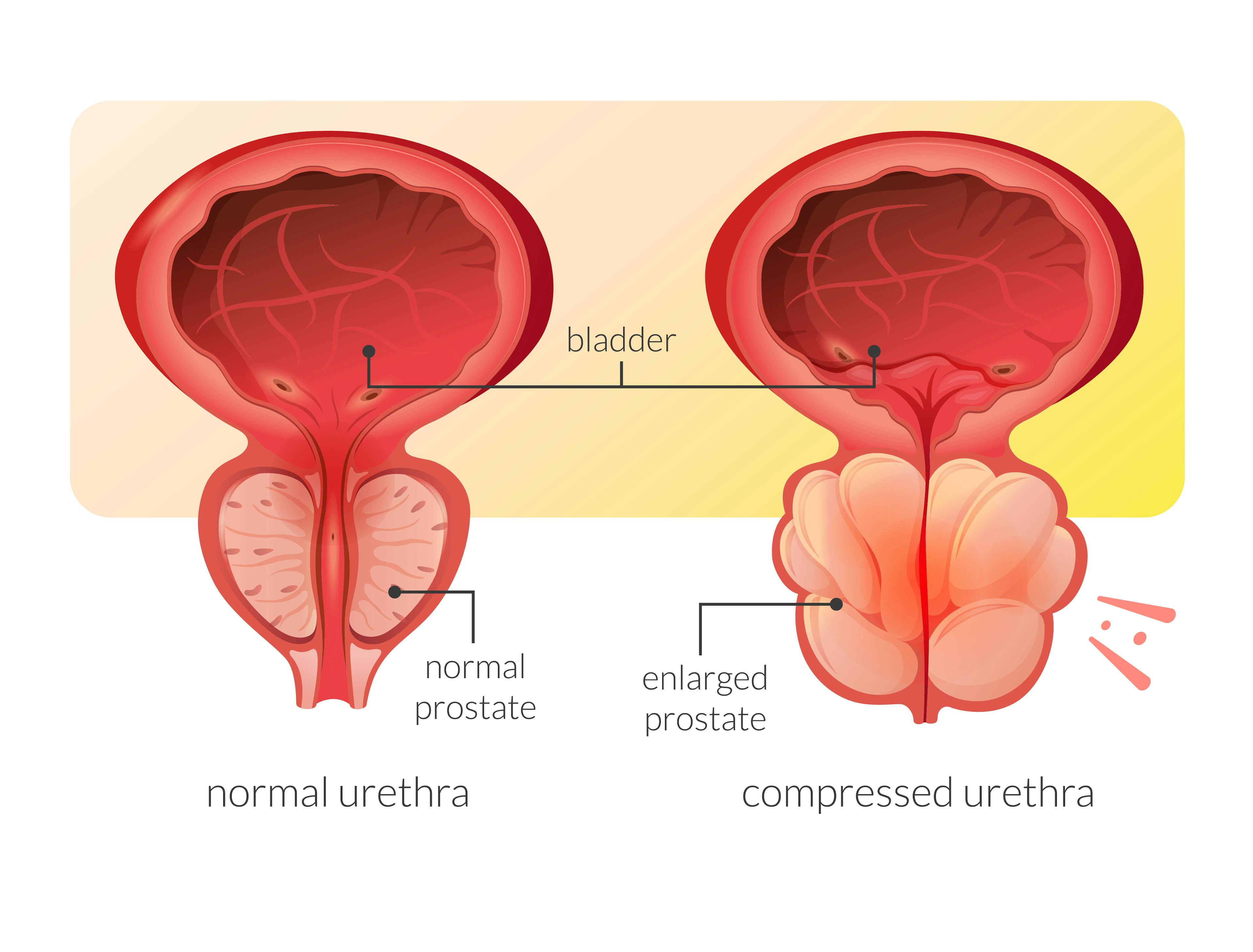As men age, many may find that their nightly routines increasingly include frequent trips to the bathroom. This common issue often stems from Benign Prostatic Hyperplasia (BPH), better known as an enlarged prostate. It’s a condition that strikes many but is often misunderstood.
Nearly half of all men in their 50s experience symptoms of BPH, and by the time they reach their 80s, up to 90% are affected. The impact of BPH goes beyond just frequent bathroom breaks; it can lead to uncomfortable urinary symptoms and significantly alter a man’s quality of life.
What is Benign Prostatic Hyperplasia (BPH)
Benign Prostatic Hyperplasia (BPH) is a non-cancerous enlargement of the prostate gland. The prostate is a small gland located below the bladder in men and surrounds the urethra—the tube that carries urine from the bladder out of the body. As the prostate enlarges, it can press against and pinch the urethra, potentially leading to bladder and urinary troubles.

Symptoms of BPH
The symptoms of BPH are often related to urinary function and may involve:
- Frequent or urgent need to urinate
- Increased frequency of urination at night (nocturia)
- Difficulty starting urination
- Weak urine stream or a stream that stops and starts
- Dribbling at the end of urination
- Inability to completely empty the bladder
Causes of BPH
While the exact cause of BPH is not well understood, it is clear that age plays a significant role in the development of the condition. Hormonal changes associated with aging, such as changes in testosterone and other growth factors, may contribute to prostate growth as well.
How BPH is Diagnosed
Diagnosis of BPH typically involves a combination of medical history, physical examination, and diagnostic tests, such as:
- Digital Rectal Exam (DRE): A physician evaluates the size and condition of the prostate through the rectal wall.
- Urine Tests: A urinalysis is performed to check for infection or other conditions that could cause similar symptoms.
- Blood Test: This test assesses kidney function and levels of prostate-specific antigen (PSA), which can indicate prostate enlargement or prostate cancer.
- Ultrasound: Used to visualize the prostate, bladder, and kidneys, and to measure the amount of urine remaining in the bladder after urination.
Treatments for BPH
Benign Prostatic Hyperplasia (BPH) can be managed using a variety of treatment options tailored to the severity of symptoms and the overall health of the individual. Treatment strategies range from medications and lifestyle adjustments to invasive surgical interventions, depending on the degree of urinary obstruction and the presence of other medical conditions.
Medications for BPH
Medications are often the first line of treatment to manage symptoms of BPH. Here are some of the most common options:
- Alpha blockers: such as Flomax and Uroxatral relax the muscle fibers in the prostate and bladder neck, making it easier to urinate.
- 5-alpha reductase inhibitors: like Proscar and Avodart reduce the size of the prostate by blocking hormonal changes that cause prostate growth.Medications are often the first line of treatment to help relax the muscles of the prostate and bladder to ease urine flow. Several treatment options are available for managing BPH.
Minimally Invasive Procedures:
- Transurethral Resection of the Prostate (TURP): Still considered the gold standard for BPH, this procedure involves removing prostate tissue to ease urine flow.
- UroLift: The UroLift prostate procedure is a newer, less invasive procedure that uses tiny implants to lift and hold the enlarged prostate tissue so it does not block the urethra. It improves urine flow and relieves symptoms of BPH such as frequent urination, weak urine stream, and difficulty urinating.
- Laser therapy: Utilizes high-energy lasers to remove the prostate tissue, facilitating better urine flow.Rezum Water Vapor Therapy: This treatment uses water vapor to target and reduce excess prostate tissue. It is a minimally invasive procedure that has been shown to effectively alleviate symptoms by reducing the pressure on the urethra.
- GreenLight Laser Therapy: A method utilizing a laser to remove prostate tissue obstructing the flow of urine. It’s known for its effectiveness and quick recovery times.
- Aquablation Therapy: Uses robotically controlled water jets to precisely remove prostate tissue without heat, minimizing the risk of sexual dysfunction and other side effects.
Surgical Treatments for BPH
In severe cases, more invasive surgery may be necessary to remove the enlarged part of the prostate. Options include:
- Open prostatectomy: Removal of the prostate gland through an abdominal incision, generally recommended if the prostate is very large, or if there are complicating factors.
- Robotic Simple Prostatectomy: Involves the use of robotic systems to assist with the surgical removal of prostate tissue, typically resulting in less pain and a quicker recovery.
When Should I See a Doctor
Men experiencing frequent urination, difficulty initiating urination, or other urinary symptoms suggestive of BPH should consult with a urologist. Early diagnosis and treatment can alleviate discomfort and prevent the progression of symptoms or complications such as urinary tract infections or kidney damage.
Need Care Now?
You don’t have to live with the discomfort of BPH. If you're experiencing symptoms of BPH, we encourage you to schedule an appointment with a specialist. Whether it's medication, a minimally invasive procedure, or advanced treatment, a urologist can determine the appropriate approach to bring you relief.
FAQs
While BPH cannot be entirely prevented, leading a healthy lifestyle is a great first step. Start by maintaining a healthy weight, exercising regularly, and consuming a balanced diet to help reduce the risk or delay the onset of urinary symptoms.
BPH and prostate cancer are not the same; having BPH does not increase your risk of prostate cancer. However, the symptoms of both are often similar, making it important to undergo regular medical evaluations to distinguish between the two.
Yes, certain lifestyle changes such as reducing fluid intake before bed, limiting caffeine and alcohol, practicing double voiding, and staying active help to manage the symptoms of BPH.
While BPH itself is not life-threatening, it can lead to serious complications if left untreated, such as complete urinary retention and kidney damage. Research suggests approximately 10% of men with BPH will eventually require surgical intervention. For those suffering from BPH, modern medicine offers a variety of effective treatments.

